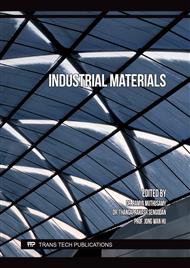p.3
p.11
p.17
p.23
p.33
p.39
p.47
p.53
Mechanical Properties of Hydroxyapatite Ceramic Prepared from Micropowder and Nanopowder
Abstract:
In this work, hydroxyapatite ceramics were prepared from hydroxyapatite micropowder and nanopowder. The hydroxyapatite nanopowder was obtained from natural buffalo bone by using a high speed vibro-milling machine for 2 hour. The green compacted pellets of all HA powders were subsequently sintered at 1200, 1250, 1300 and 1350°C for 3 hour and then the physical and mechanical characterizations as well as microstructural evaluation have been carried out. It was found that the optimum sintering temperature were 1250°C by fabricated from nanopowder which gave the HA nanoceramic with the maximum bending strength of 78.6±2.6 MPa. This is about 200% higher than that of the sample which fabricated from HA micropowder.
Info:
Periodical:
Pages:
17-22
Citation:
Online since:
November 2022
Authors:
Keywords:
Price:
Сopyright:
© 2022 Trans Tech Publications Ltd. All Rights Reserved
Share:
Citation:



